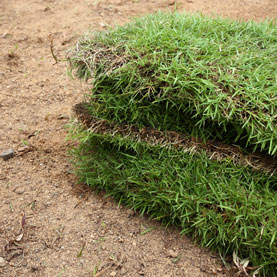
Preventing & Managing Soil Erosion
Apr 05th 2019
What Is Soil Erosion?
Any home or business landscape is at risk of erosion, but the degree to which soil erodes can vary due to a number of factors. At the core, soil erosion occurs when water carries away topsoil or the top layer of soil.
This quickly becomes an issue beyond an unsightly appearance — the runoff carries away the nutrient source used by plants and trees but it can also introduce landscape pollutants, such as fertilizer and pesticides.
The first step in correcting an erosion problem is identifying the issue. Look for exposed roots, mud-splashed surfaces, and puddles after watering with irrigation or rainfall. Soil erosion is most prevalent in sloped areas but can affect any part of a landscape.
Is Soil Erosion Preventable?
Yes, to a degree. One way to prevent soil erosion is to make sure the soil has some type of year-round cover to protect the topsoil from rain- and wind-driven runoff. In addition, having a lawn care company, such as Evergreen Lawn Care evaluate the lawn or landscape and design a custom plan can help minimize erosion as much as possible. We’ll provide guidance on what to do to prevent soil erosion in between landscaping services.
How To Manage Landscaping Soil Erosion
Stabilize The Existing Soil
The first step in preventing and managing this common lawn condition is to stabilize the existing soil. This can be done with temporary means such as mesh sheets, mulch, and straw bales. But permanent methods, such as the five listed below, offer the best long-term solutions to soil erosion. No matter the size of the landscape, we can help stabilize the soil by combining different methods to best handle condition and meet the needs of the area. Contact us today to schedule an appointment.
Plants
Once established, plants' root systems help anchor the soil and stop erosion. They’re frequently used in conjunction with other erosion control methods but can be designed to work alone. Ornamental grasses, perennial native plants, and wildflowers are known to quickly acclimate to unimproved areas.
Riprap
Granite is the most common stone used for riprap, the term used to describe loose and rough stones at least 6- to 8-inches in width. The stones are embedded or spread loosely on top of the eroding area. As water flows through the area, it diverts around the exposed stones and disperses across a wider zone.
Terraces
This method is what creates the prominent stair-step look in many landscapes. Terraces are generally made from retaining walls, created with various materials, such as concrete, precast blocks, or stone. Rainfall and water soak into the terraced areas rather than running off into the adjacent lawn.
Turfgrass
If the turfgrass is healthy, it can serve as an effective way to stabilize your landscape's existing soil. Certain varieties of turfgrass, such as Bermuda grass, both germinate and establish in a relatively short amount of time. This allows perennial grasses extra time to establish but controlling runoff in the meantime.
Baffles & Barriers
These devices obstruct the flow of water through planned diversion with partially buried stone and/or timbers. This method is most effective for minor slopes.
Use Measured & Targeted Watering
We don't always know when Mother Nature will water the lawn. Creating a strategic watering schedule is a great way to combat erosion. If you’re irrigation system is in need of repairs, call Evergreen Lawn Care.
Plant & Water In Zones
Planting similar varieties of plants, shrubs, and other types of vegetation within the same area of a lawn or landscape can create zones which are easier to care for with regard to the plants' watering needs. With a zoned planting and watering schedule, you'll be able to conserve water while reducing soil erosion which, in turn, helps keep the landscape healthy.
Focus On Deep Watering
Certain kinds of vegetation, such as grasses, perennials, and most annuals, thrive when they receive a deep watering every few days rather than frequent, scant watering. Allowing water to soak into the root system allows the roots to grow and act as a soil stabilizer. Plan for deep watering two to three times per week during warmer months and adjust the schedule for rainfall.
